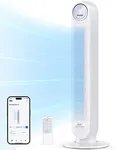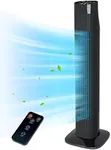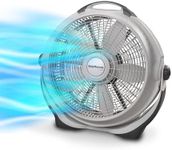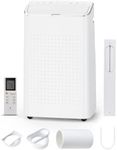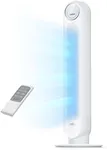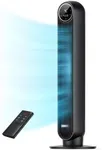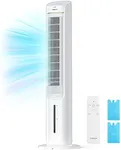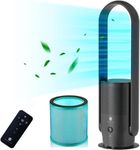Buying Guide for the Best Cooling Fan For Room
Choosing the right cooling fan for your room can make a significant difference in your comfort, especially during hot weather. The right fan will not only cool the room effectively but also operate quietly and fit well within your space. To make an informed decision, you need to consider several key specifications that will help you find the best fit for your needs.Fan TypeThe type of fan is crucial as it determines how the air is circulated in the room. Common types include tower fans, pedestal fans, box fans, and window fans. Tower fans are sleek and space-saving, ideal for small rooms. Pedestal fans are adjustable in height and can cover larger areas. Box fans are versatile and can be placed on the floor or in windows. Window fans are installed in windows to pull in fresh air or exhaust hot air. Choose a fan type based on the size of your room and where you plan to place it.
Airflow (CFM)Airflow, measured in cubic feet per minute (CFM), indicates how much air the fan can move. Higher CFM means more air circulation, which is essential for cooling larger rooms. For small rooms, a fan with a lower CFM (around 100-300) is sufficient. Medium-sized rooms may require a fan with a CFM of 300-500, while large rooms or open spaces might need a fan with a CFM of 500 or more. Consider the size of your room and how much airflow you need to stay comfortable.
Noise LevelThe noise level of a fan is measured in decibels (dB). A quieter fan is preferable for bedrooms or offices where noise can be disruptive. Fans with noise levels below 50 dB are considered quiet and suitable for such environments. For living rooms or areas where some background noise is acceptable, fans with noise levels up to 60 dB can be used. If you are sensitive to noise or need a fan for a quiet space, look for models specifically labeled as 'quiet' or 'silent'.
OscillationOscillation refers to the fan's ability to rotate from side to side, distributing air more evenly throughout the room. This feature is important if you want to cool a larger area or multiple people. Fans with oscillation can cover a wider space compared to stationary fans. If you need to cool a specific spot, a non-oscillating fan might be sufficient. For broader coverage, choose a fan with a wide oscillation range.
Speed SettingsSpeed settings allow you to control the intensity of the airflow. Most fans come with at least three speed settings: low, medium, and high. Some advanced models offer more precise control with additional speed options. If you need flexibility in cooling, look for a fan with multiple speed settings. This way, you can adjust the airflow to your comfort level, whether you need a gentle breeze or a strong gust of air.
Energy EfficiencyEnergy efficiency is important to keep your electricity bills low and reduce environmental impact. Look for fans with energy-saving features or those that are Energy Star certified. These fans use less power while providing effective cooling. If you plan to use the fan frequently or for long periods, an energy-efficient model will be more cost-effective in the long run. Check the fan's wattage and energy consumption details to make an informed choice.
Size and PortabilityThe size and portability of the fan determine how easily you can move it around and where you can place it. Compact and lightweight fans are ideal for small rooms or for moving between different areas. Larger fans may provide more powerful cooling but can be harder to move. Consider the space you have available and whether you need a fan that can be easily relocated. If portability is important, look for fans with handles or wheels.
Additional FeaturesAdditional features can enhance the functionality and convenience of your fan. These may include remote control, timer settings, air purification, or ionizer functions. A remote control allows you to adjust settings from a distance, while a timer can help you save energy by turning the fan off automatically. Air purification features can improve air quality, which is beneficial if you have allergies. Consider which additional features are important to you and how they can improve your overall experience.




